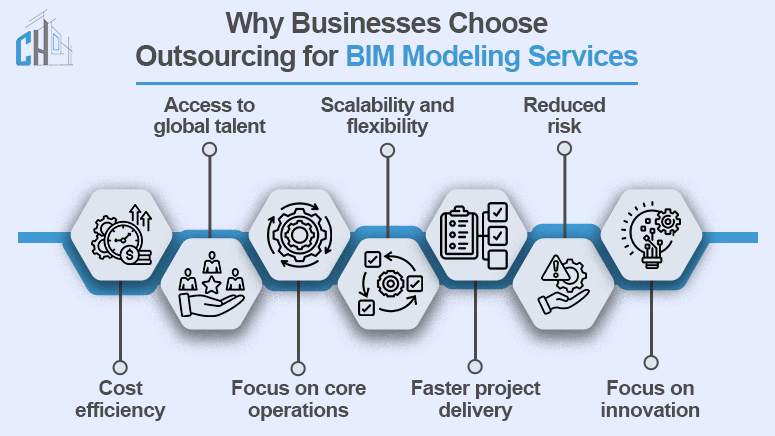Quick summary: Find out if outsourcing architectural BIM services is the right decision in 2025 for your enterprise. Discover common BIM outsourcing strategies, reasons for outsourcing, and BIM checklists at this stage of modeling. Use this ultimate guide to outsourcing BIM services to enhance the efficiency of the BIM work process.
Outsourcing is fast becoming a popular strategy in organizations that seek to plot their future in the construction of architecture. In partnering with external service providers this approach helps companies to stay on strategic business areas as they outsource other specialized functions such as the architecture BIM service and BIM drafting to off-shoring specialists. It is cheap and offers a chance to reach talents all over the world.
Nevertheless, outsourcing has its disadvantages like organizational culture differences and weak communication, There are also some problems with product quality. Businesses need to look at partners and make some determinations.
Nevertheless, outsourcing building information modeling remains an ongoing business model though many small and large companies apply this model to remain innovative.
Outsourcing is evolving and new models giving far greater flexibility and effectiveness are being formulated. As outsourcing grows more and more into executives’ plans, it becomes useful to know whether or not it is for your company. Let’s dig deeper into this.
Outsourcing models for businesses of all sizes
Even when outsourcing BIM modeling the model you settle for depends on the size of your business as well as the particular needs that you have.

Fixed-Price Model
A fixed-price model is one of the most coherent and simple engagement models in which both the service provider and the client decide on the overall price for the project before the works begin. This model is particularly beneficial where the scope, timeline, and output of a project are well-defined and enables firm-client budget confirmation and allows the minimization of financial exposure.
The disadvantage of a fixed-price structure is that it makes project control easier as the price does not vary during work on a project. But it could also reduce the level of flexibility; in case of changes, requests for modification of the scope and/or the price may be required, which may lead to conflicts.
Advantages
Budget Certainty: Clients are aware of the price that they will need to part with in order to access the supplied services or products.
Clear Expectations: Deliverables, time, and cost are clear to both parties and they are agreed to by the two partners involved in the partnership.
Less Administrative Overhead: Reduces the complexities of making bills and generating invoices.
Dedicated Team Model
The Dedicated Team model is an agreement whereby we offer a team of dedicated BIM modelers at a contractual basis. In this case, we have to look for and estimate those employees who would be able to execute the given project to the maximum and meet all the needs.
The specialists employed are selected according to the previous work done, languages, field specialty, and technical knowledge. To this end, we put together a Revit BIM modeling team that will directly engage with you, thus offering your project the level of efficiency that is possible.
It can be managed by you directly or by a project manager that we can have in our team for such a purpose. The dedicated team is synchronized with your internal team thus enhancing the technical competency in relation to your business and in harmony to tailor solutions to the projects.
At the end of our cooperation, we provide you with the ready-to-go product accompanied by the technical specification, BIM model as well as all the related IPR.
Time and Material Model (T&M)
Time and Material (T&M) is the most flexible model that has been gaining popularity in recent years. It works on a pay-per-hour basis, allowing businesses to increase or decrease team size depending on project needs.
This model is suitable for companies working on dynamic projects that require quick turnaround times. T&M also allows for better quality control as clients can monitor progress closely and make adjustments when necessary.
Offshore outsourcing
Outsourcing means to hire teams in other areas which are, as a rule, located in other states where the cost of labor is generally lower. This model is well suitable for outsourcing of architecture BIM Modeling for the new business and companies that want to cut down their expenses.
Offshore outsourcing enables reaching out to a talent pool from another locality but has issues such as language and time differences. Offshore outsourcing is done usually in developing countries such as India and Eastern European countries.
When should you consider architecture outsourcing BIM Modeling?
There are very many benefits of BIM outsourcing services can offer a business and how then can a business know that it is time to start using it? Here are a few clear signs that outsourcing might be what your business needs:

1. Lack of access to skilled technical talent
For organizations that experience some form of difficulties in employing complex technologies or developing complex projects, outsourcing gives companies a pool of talented dedicated developers from all over the world.
This solution has benefits for those startups and small businesses that need to receive high-quality services without hiring people ona regular basis.
2. High operational and modeling costs
Outsourcing becomes viable when the expense of recruiting a team, training, and sustaining employees is expensive for your business.
When selecting BIM modeling outsourcing models, allows companies to cut overhead costs while still enjoying good work.
3. Time-to-market pressures
Sanity or competitive pressures in the marketplace require that new products be developed in shorter time spans.
Outsourcing makes it easier for you to involve outside teams who know how to deliver your product on time to the market.
4. Your focus is on core business activities
Managing BIM Outsourcing & Consulting internally can distract you from core operations like customer engagement and strategic growth.
Outsourcing helps you delegate technical work while you concentrate on driving business success.
By recognizing these signs, you can determine whether BIM modeling outsourcing for your business is the right choice.
Why Businesses Choose Outsourcing for BIM Modeling Services
Outsourcing architecture BIM modeling services has become a popular strategy for a variety of industry verticals looking to optimize operations and remain competitive. Here are some key reasons why companies choose to outsource:
1. Cost efficiency
BIM Outsourcing Services normally will cost less than maintaining BIM staff internally, salaries and wages for BIM experts, and training expenses. To startups and small businesses, or any business in those developing countries, it makes high-quality services easily achievable at low cost.
2. Access to global talent
Outsourcing is an opportunity for businesses to work with developers from all over the world, have high qualifications. This is particularly valuable for companies that need to access expertise in specific segments or new/greater time tools.
3. Focus on core operations
Outsourcing BIM modeling means that the businesses are able to focus on their core business functions like problems, change, and clientele services without necessarily being bogged down by technicalities.
4. Scalability and flexibility
It allows business organizations to adjust their workforce up or down as the demands of the project require. This way is quite helpful for companies that are dealing with the variability of workloads, especially startups and enterprises.
5. Faster project delivery
Outsourcing teams usually have the experience and already set methodologies in place to shorten the timeline for modeling. The right outsourcing model for business guarantees that projects are done to the best standard.
6. Reduced risk
Advanced outsourcing suppliers are able to control risks more effectively due to the enhanced knowledge in project administration, technologies, and time schedules.
7. Focus on innovation
Outsourcing also maintains a business’s competitiveness since suppliers deliver new approaches to work while the business’s internal team focuses on long-term architecture BIM projects.
Outsourcing is a managerial decision that a company takes in its attempt to attain efficiency and its capacity for growth. In the previous section, we got an understanding of why businesses opt for outsourcing, now let’s go straight to when one should opt for outsourcing.
Key Factors to Consider When Outsourcing BIM Modeling
Even in analyzing whether outsourcing is properly suited to a certain enterprise, there is also some comprehensiveness to it. Use this checklist to make an informed decision:
1. Assess your business needs
- Identify the skills or expertise your team lacks.
- Evaluate if your project requires specialized knowledge or advanced tools.
- Consider your budget and timeline constraints.
- If your in-house resources can’t meet the demands, outsourcing BIM modeling for business could be the solution.
2. Choose the right outsourcing partner
- Research potential outsourcing providers and their expertise.
- Check client reviews, case studies, and references.
- Ensure the partner understands your industry and project requirements.
- A reliable outsourcing model for business ensures a smooth collaboration.
3. Define clear goals and expectations
- Outline project objectives, deliverables, and timelines.
- Establish communication channels and reporting structures.
- Set metrics to measure success and track progress.
- Clarity helps keep your architecture BIM modeling outsourcing costs in line with your business goals.
The application of this checklist ensures that the outsourcing of business tasks is appropriate to your business needs as well as to the achievement of business objectives. Now, what next? You may be thinking of your requirements & how does outsourcing actually start? Here you go!
Also read: Find the ideal 3D Revit BIM outsourcing partner for your 2024 projects!
Strategies for Overcoming Outsourcing Challenges
Outsourcing also comes with some challenges. Addressing these effectively can make your outsourcing journey smooth and successful.
| Challenges | Solutions |
| Communication barriers | An organization must communicate well with its business partners set and convey expectations and arrange to check on the progress frequently. Make use of certain betterment tools to make it easier to track projects. |
| Time zone differences | Choose a situation in which there is a considerable overlap of working shifts or establish time boundaries between the two teams. If so, change your working time schedule to increase the clock-wise correlation. |
| Cultural differences | Learn cultural differences and embrace everyone around you by being a good sport. Guide people and teams to have frank and constructive communication and acknowledge other folks’ inspirations and opinions. |
| Quality control | Produce quality measurements and be certain to carry out advanced checks as frequently as you can. Implement Revit Software with the approach of ideas concerning feedback and loops. |
| Data security and confidentiality | Sign NDAs and ensure that the outsourcing company follows best practices for data security. Implement secure communication and file-sharing systems. |
| Hidden costs | Set a clear budget and define the scope of work upfront to avoid hidden costs. Negotiate fixed-rate agreements or detailed hourly rates for transparency. |
| Misaligned goals | It needs to be agreed back and forth as to what the expectations from each other are. Have some goals, time, and a way to measure success to help eradicate confusion as well as the mismatch of expectations. |
| Lack of control over the project | Structure good governance and reporting at Queensland Health. It sets goals and checks how far the project has gone as it moves to avoid derailing. |
How Outsourcing Boosts Innovation and Reduces Costs for Businesses
Hiring professional firms for architecture BIM services gives various benefits that can in turn assist companies in enhancing their productivity and advancement.
1. Cost efficiency and scalability
Outsourcing is beneficial in the operations cost sense because it does not encourage internal recruitment or establishment of infrastructure. This has given organizations an opportunity to hire talent from all over the world without having to offset full cost of an employee.
It also provides flexibility and enables organizations to manage their resources depending on the magnitude of a project. Thus, the findings reveal that flexibility good confirms that companies can balance their budgets appropriately while responding to increasing needs.
2. Access to diverse outsourcing models
Outsourcing has different types of models including offshore models, nearshore models, as well as hybrid models, allowing the business to choose the best one. These models offer easy solutions for anyone wanting to achieve better organization and possibly, cost efficiency.
Due to such diversity, outsourcing benefits small and big businesses by availing the opportunities when the business may lack specific resources or skills in completing projects in a particular manner and within a short time.
3. Focus on innovation
Outsourcing non-core modeling implementations enables business organizations to concentrate on the core innovation and strategies. Tasks solved through outsourcing providers are mostly operational and leave core teams with more time focused on value-added work such as expansion and product innovation.
This shift helps to accelerate what innovation that is occurring and actually encourages creativity while refocusing resources on the future.
Conclusion
Outsourcing BIM services offers cost efficiency and scalability, helping businesses reduce expenses and access global talent. The right model optimizes resources for specific project needs.
Shifting non-core tasks to outsourcing BIM modeling partners allows businesses focus to on innovation and strategic growth, letting internal teams concentrate on key areas for success.
Each business outsource model is currently available meaning that various businesses from different industries will always find solutions needed depending on the goals to be achieved including enhanced communication, reduced costs, and short time in getting products to market.




